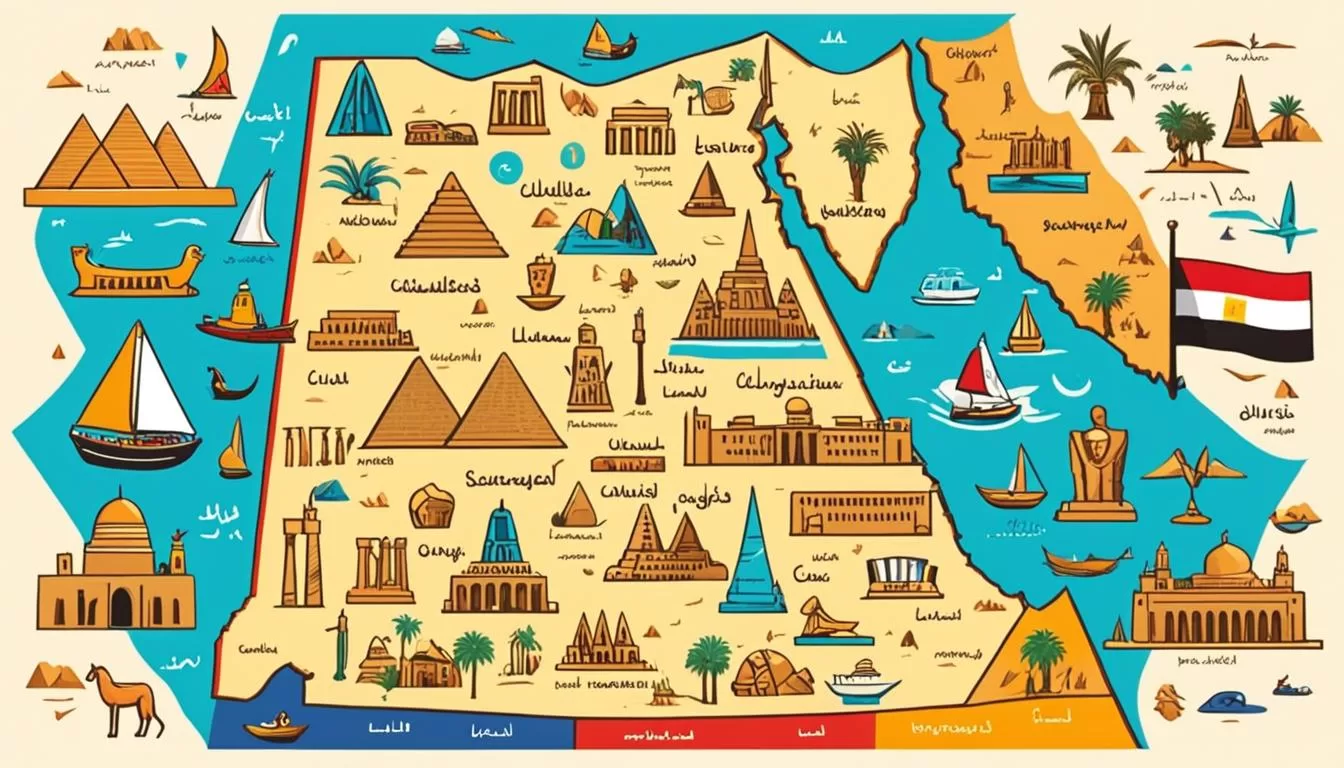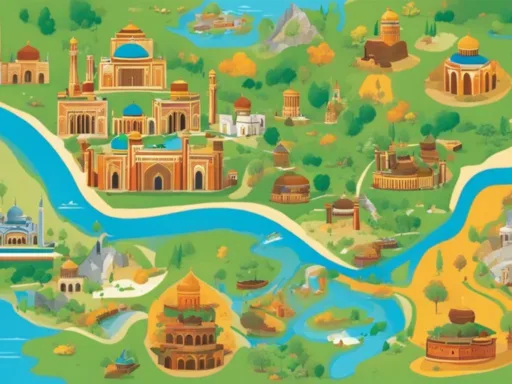Egypt, known for its ancient civilization and rich cultural heritage, is also a land where linguistic diversity paints its contemporary social landscape. While the Arabic language in Egypt serves as the official script, a broader examination reveals a mosaic of tongues that span across its deserts, cities, and valleys. The languages spoken in Egypt stretch beyond the parameters of a single dialect or tradition, reflecting centuries of history, trade, and immigration.
The Egyptian population communicates using a spectrum that ranges from the widely spoken Egyptian Arabic to various minority dialects, representing a true embodiment of linguistic diversity in Egypt. Moreover, foreign tongues such as English and French play significant roles in trade, education, and tourism, highlighting an ever-present global influence. Thus, understanding the multifaceted nature of the Egyptian language situation offers a glimpse into the nation’s soul.
Among the rippling dunes and bustling city streets, Egypt’s linguistic repertoire thrives, shaping the narrative of its people and preserving the enduring legacy of its ancestors.
Key Takeaways
- Egypt’s linguistic variety is due in part to the official language, Standard Arabic, and the common spoken form, Egyptian Arabic.
- Minority languages enrich Egypt’s cultural fabric, including dialects like Sa’idi Arabic and Nobiin.
- Foreign languages, especially English and French, indicate Egypt’s strong historical ties and global connectivity.
- The multilingual landscape in Egypt is a testament to the country’s wide-ranging historical and contemporary influences.
- The integration of native and global languages underscores Egypt’s role as a cultural crossroads.
The Linguistic Landscape of Egypt’s Population
In the heart of the Middle East, Egypt emerges as a vibrant quilt of spoken languages in Egypt, each thread a narrative of its rich history and cultural interactions. As one traverses from the bustling markets of Alexandria to the tranquil banks of the Nile in Aswan, the echoes of diverse dialects speak volumes about multilingualism in Egypt. This colorful linguistic landscape is not merely a byproduct of social nuances but is also intricately woven into the language policy of Egypt, aiming to preserve a legacy while embracing new global paradigms.
At the center of the Egyptian linguistic stage is Egyptian Colloquial Arabic, or ‘Masri’, which rings familiar in the ears of the local populace and is etched into the sand stones of its cities. This vernacular supports an informal communication network that transcends the nation’s geographical divides. However, as if mirroring the layers of an ancient papyrus, Egyptian Arabic is overlaid by the more formal Literary Arabic, the esteemed official language of state and academic pursuit. This duality highlights the dynamic balance between daily life and formal discourse.

Literary Arabic, with its ancestral roots, graces official documents and is the language of intellectuals, preserving the past yet not fully capturing the present’s vocal essence. Contrastingly, the Egyptian streets bustle with local vernaculars—a testament to adaptability and evolution. From the Siwi Berber of the western oases to the Bedouin dialects of the eastern deserts, each breathes life into Egypt’s identity.
As the country’s proverbial doors have opened to foreign influences, a host of global languages have also found their footing within. English and French, in particular, serve as modern-day adjuncts to Egypt’s multilingual mosaic, bringing with them a touch of the West on the bedrock of tradition.
It would be remiss to overlook the minority languages that add complexity to Egypt’s multicultural dialogue. A glimpse at the southern reaches reveals Sa’idi Arabic spoken by locals, while the serene wends of the Nile are home to the music of Nubian languages like Nobiin. Just as sands shift, so too does the country’s linguistic narrative, as each language leaves an indelible mark on the social and cultural fabric of Egypt. Through the lens of language policy Egypt fosters, one witnesses an enduring commitment to linguistic heritage, while also charting a course through the seas of globalization.
Egypt’s linguistic panorama is not an artifact but a living, evolving entity that transcends the mere function of communication. It is a bastion of cultural identity, an evergreen garden of syllables and sounds that continues to shape and be shaped by those who walk upon its ancient land.
Modern Standard Arabic: Egypt’s Official Script
Within the landscape of Egypt’s linguistic heritage, Modern Standard Arabic, also known as Modern Literary Arabic, stands as the official language of Egypt. While it carries the time-honored traditions of Classical Arabic, its role today extends into various sectors of society, emphasizing its stature as the connective thread in Egypt’s educational systems and formal interactions.

The Role of Modern Standard Arabic in Education
Modern Standard Arabic (MSA) is more than a language; it’s an institution. Its presence in the realm of education in Egypt is indisputable, facilitating the transmission of knowledge and scholarly discourse across Arabic-speaking nations. The intricacy of MSA grammar and syntax, which remains profoundly rooted in its Classical antecedents, provides a foundation for intellectual rigor and cognitive development within Egyptian academics.
Literary Arabic vs. Vernacular Arabic Dynamics
The dynamics between Literary Arabic and Vernacular Arabic showcase the flexibility and adaptability of the Arabic language in Egypt. While MSA is prevalent in formal arenas, the colloquial tongues of the Egyptian people reflect a more immediate and personal means of communication, illustrating the diverse linguistic experiences throughout the nation.
| Aspect | Modern Standard Arabic | Egyptian Vernacular Arabic |
|---|---|---|
| Usage Context | Formal and Academic | Colloquial and Daily Interactions |
| Written Tradition | Official Documents, Literature | Limited to Informal Texts |
| Geographical Reach | Pan-Arabic | Mainly Egypt |
| Linguistic Roots | Classical Arabic | Mixture of Arabic, Coptic, and Other Influences |
| Learning Environment | Schools and Higher Education | Home and Community |
The dialogue between the standard and the colloquial dialects manifests not only in the verbal arena but also significantly influences Egypt’s textual and written spheres, reinforcing the vital importance of Arabic in forging a united yet diverse national identity.
Languages Spoken Egypt: A Deep Dive
The rich tapestry of languages spoken Egypt is emblematic of the nation’s long history as a cradle of civilization and a crossroads for different cultures. The recognized linguistic diversity in Egypt is a direct result of a dynamic confluence of people and traditions over the millennia.
Egyptian Arabic may dominate as the de facto language of the masses, but a kaleidoscope of minority languages and dialects collectively narrate a story of Egypt’s pluralistic identity. Take the enduring voice of Sa’idi Arabic, prevalent among the denizens of the country’s south, or the harmonious Nobiin, the Nubian tongue that weaves throughout the bustling Upper Nile Valley. The distinct linguistic milieu is further enhanced by the uniquely Egyptian use of the rich Berber dialects such as Siwi within the confines of the Siwa Oasis.

Adding a layer of inclusivity and recognition to the linguistic diversity in Egypt is Egyptian Sign Language, catering to the communication needs of the deaf community. It stands as a testament to the accommodative ethos embedded in Egypt’s societal fabric. Meanwhile, immigrant languages such as Greek, Armenian, and Italian have been introduced by their respective diasporas, seamlessly integrating into the nation’s historical and contemporary cultural dialogue.
The voices of Egypt are many, and each tells a unique story of mingling heritages and evolving vernaculars.
Below, a detailed table showcases the diverse spectrum of languages spoken Egypt and their respective contexts, further illustrating the country’s vast linguistic diversity:
| Language/Dialect | Usage | Region | Percentage of Population* |
|---|---|---|---|
| Egyptian Arabic | Vernacular / Daily use | Nationwide | 70% |
| Sa’idi Arabic | Vernacular / Local Communities | Southern Egypt | 22.73% |
| Nobiin | Vernacular / Cultural Expression | Upper Nile Valley | 0.3% |
| Siwi Berber | Vernacular / Native Speakers | Siwa Oasis | 0.02% |
| Egyptian Sign Language | Communication / Educational Services | Varied Urban Centers | Data not available |
| Greek, Armenian, Italian | Immigrant Communities / Cultural Preservation | Localized, e.g., Alexandria, Cairo | Data not available |
*Percentages are estimates and may not reflect current data.
Each of these languages serves as a cultural vessel, carrying within its syntax and vocabulary the imprints of trade, conquest, migration, and day-to-day life that have shaped the nation’s evolution. In Egypt, language is not merely a tool for communication; it is a living history book, a narrative of shared experiences, and a blueprint for understanding a nation’s past as well as its ongoing societal journey.
Egypt’s Rich Tapestry of Regional Dialects
The vibrancy of Egypt’s dialects is a reflection of its diverse cultural heritage. Key to this linguistic enigma is the predominance of Egyptian Colloquial Arabic, which acts as a binding force among the people, shaping the day-to-day interactions and cultural expressions in the region. This intricate web of dialects, spoken from the shimmering sands of the Sahara to the verdant banks of the Nile, not only tells a story of the present but is also a reverberation of the nation’s multifaceted past.
Egyptian Colloquial Arabic: The Dominant Dialect
Heralded as the lingua franca of Egypt, Egyptian Colloquial Arabic, or Masri, resonates throughout the bustling souks and tranquil villages. Masri, deeply ingrained in the collective consciousness of the populace, showcases a unique hybridity, its idioms and nuances painted by an array of historical influences from the ancient Egyptian language to modern-day colloquialisms.

Dialects Spoken by the Bedouin and in Upper Egypt
In the vast stretches of the Eastern and Western deserts, one may hear the distinctive dialects of the Bedouins, a rich oral tradition echoing their nomadic heritage. Moreover, the dialects of Upper Egypt, separated by geography and social customs, add a distinctively indigenous cadence to the broader soundscape of Egyptian vernaculars, revealing the depth and nuance of the Arabic language in Egypt.
The Nubian Languages of the Nile Valley
The tapestried narrative of Egyptian dialects would be incomplete without the melodic lilt of the Nubian languages, particularly Nobiin. Evocative of the Nile Valley’s ancient grandeur, these languages safeguard a legacy that is emblematic of Egypt’s cultural variety. Nobiin, aside from its everyday use, stands as a cultural emblem, highlighting the importance of regional languages in preserving the complex identity of the nation’s people.
Historical Tongues: Coptic and Ancient Egyptian
The majestic pyramids of Egypt are not the sole guardians of its profound history; the nation’s linguistic heritage, particularly the Coptic language and the ancient Egyptian language, also serve as a testament to its storied past. These classical tongues, though no longer the vernacular, remain significant as scholarly pursuits and liturgical hallmarks, offering us insights into the dawn of Egyptian civilization.
Coptic Language: A Liturgical Relic
The Coptic language, though scarcely spoken in daily life today, holds an esteemed position as the living descendant of the pharaonic Egyptian language. Integrated deeply into the religious fabric of Egyptian Copts, Coptic is utilized predominantly within the rituals and hymns of Coptic Christianity. A link to early Christian roots, this liturgical language is a bridge between the modern-day faithful and their venerable ancestors, echoing within the walls of chapels and monasteries throughout Egypt.
Ancient Egyptian Hieroglyphs: Understanding Egypt’s Origins
The enigmatic ancient Egyptian language, manifested through hieroglyphs carved upon monuments and papyrus scrolls, holds the keys to unlocking countless secrets of antiquity. This symbolic script, one of the earliest known writing systems, provides an unparalleled window into the lives, beliefs, and wisdom of early Egyptians. Today, hieroglyphic studies enlighten us further about the nuances of ancient Egyptian society, ensuring that this magnificent culture’s practices, lore, and insights persist across millennia.

Foreign Languages in Egypt: A Sign of Globalization
The narrative of Egypt’s linguistic lineage continues to unfold with the notable presence of foreign languages in Egypt. English, widely recognized as a lingua franca of global commerce and digital communication, has cemented its position within Egyptian society. It’s not merely a subject on the school curriculum but a gateway language in tourism and higher education institutions such as the British University in Egypt and the American University in Cairo. Such prominence of English is indicative of the country’s pivot towards modernity and its interconnectedness with international communities.
Adjacent to English in linguistic importance stands French, with its roots entrenched in Egypt’s history and its branches reaching for contemporary relevance. The proliferation of French throughout Egypt’s education system, seen in the rise of French-speaking populations and the sustained circulation of French media, echo its lasting influence. This enduring presence is a reminder of multilingualism in Egypt being as much about historical continuity as it is about meeting the demands of a globalized world.
Moreover, the colorful patchwork of immigrant languages – Greek, Armenian, and Italian – each tells a tale of waves of migration and the entrenched multicultural essence of Egyptian cities. The coexistence and interaction of these languages with the native tongue is a testament to Egypt’s role as a cultural conduit, a space where tradition and global influence embark on a continuous dance. Accordingly, multilingualism in Egypt not only tells the story of its historic cross-cultural engagements but also envisions the trajectory of its future in a progressively globalized society.
FAQ
What languages are spoken in Egypt?
Egypt is multilingual. The official language is Modern Standard Arabic. Egyptian Arabic is the most widely used spoken dialect. Minority languages include Sa’idi Arabic, Eastern Egyptian Bedawi Arabic, Nobiin, and others. English and French are prominent foreign languages used in education, business, and by the tourism industry.
How does the linguistic diversity of Egypt reflect its population?
The linguistic diversity in Egypt mirrors its multicultural society. The various languages and dialects, including the dominant Egyptian Arabic, regional vernaculars, and minority languages, along with the usage of English and French, showcase the rich tapestry of cultural and historical influences that shape Egypt’s demography.
Why is Modern Standard Arabic important in Egypt?
Modern Standard Arabic is the official language of Egypt, used in formal communication, literature, and education. It retains the legacy of Classical Arabic with its grammar and syntax, serving as a unifying script across the Arabic-speaking world, including in Egypt.
What is the role of Modern Standard Arabic in education?
Modern Standard Arabic is the medium of instruction in most educational settings in Egypt. It is used for teaching, textbooks, official examinations, and is considered essential for academic and professional advancement.
How do Literary Arabic and Vernacular Arabic differ in Egypt?
Literary Arabic, or Modern Standard Arabic, is the formal language derived from Classical Arabic, standardized across the Arab world and used in written communication and formal speech. Vernacular Arabic refers to the various local dialects spoken daily by Egyptians, with Egyptian Colloquial Arabic being the most widespread, differing substantially in pronunciation, grammar, and vocabulary from the literary form.
What regional dialects are spoken in Egypt?
Besides Egyptian Colloquial Arabic, other regional dialects include Sa’idi Arabic in the south, Bedouin dialects in the deserts, and the distinct languages of the Nubian communities in the Nile Valley. Each region’s dialect or language reflects its unique cultural identity and history.
What is Egyptian Colloquial Arabic and who speaks it?
Egyptian Colloquial Arabic is the dominant spoken dialect characterized by its simplicity and widespread comprehension across Egypt. It is the everyday language of the majority of Egyptians and is also understood throughout the Arab world due to the popularity of Egyptian media.
Can you tell me about the Nubian languages of the Nile Valley?
The Nubian languages, primarily Nobiin, are spoken by the Nubian people along the Nile Valley, especially in Southern Egypt and Northern Sudan. These languages belong to the Nilo-Saharan language family and are part of the cultural heritage of the ancient Nubian civilization.
What’s the significance of historical languages like Coptic and Ancient Egyptian in contemporary Egypt?
Historical languages such as Coptic and Ancient Egyptian hold significant cultural and religious importance. Coptic is used in the liturgy of the Coptic Orthodox Church and is a direct descendant of the Ancient Egyptian language, which can be seen in historical inscriptions and documents. While not used in everyday conversation, these languages are key to understanding Egypt’s rich history.
What foreign languages are commonly used in Egypt?
English is the most common foreign language in Egypt, widely used in higher education, business, and tourism. French also holds a significant place in Egypt’s language landscape due to historical links and is taught in many schools. Other foreign languages spoken include German, Italian, and Spanish, mainly within educational contexts, expatriate communities, and among those involved in international business and tourism.






